Welcome to Part 2 of my “First Steps” project, which focuses on restriction, guidance, and freedom in the initial moments of open world games. You may find it helpful to visit Part 1 for an introduction to the project and an overview of my line of inquiry. In the coming weeks, I’ll also be playing The Legend of Zelda: Breath of the Wild, Horizon Zero Dawn, Fallout 4, The Witcher 3: Wild Hunt, and Grand Theft Auto V.
I hope you enjoy my observations and reflections on the opening of Skyrim!
The Elder Scrolls V: Skyrim — Developed by Bethesda Softworks, Nov. 11, 2011
- Played on PlayStation 4
- Time played: 51 minutes
Spoiler Warning: While I avoid major spoilers for the games discussed as part of this project, know that minor spoilers may lie ahead. Discussion of each game’s plot/narrative elements does not exceed the first 2 1/2 hours of play.
Observations:
After a brief loading screen, Skyrim began with my character sitting in the back of a wagon. I was a prisoner with hands bound. (For ease of expression, I’ll default to first person when referring to my actions as the game’s protagonist.) The only actions I was permitted included looking about at my fellow prisoners and accessing the menu. Several of the prisoners spoke to me, but I remained silent as the wagon was pulled into a small community known as Helgen.
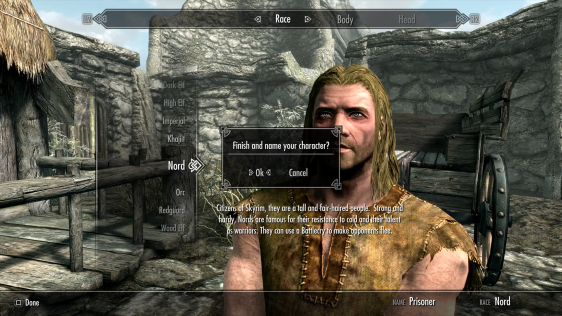
The wagon stopped, and we were ordered out and up to an Imperial guard who was taking down our names. This started the character customization menu which included typical options for gender, race, and other physical attributes.
After the customization screen, I was led to the chopping block (again, I could do nothing but glance around). Just as I was set up for beheading, a creature, a dragon, landed and chaos erupted about me. I managed to get up and follow the first fellow in front of me, conveniently marked with a small icon above his head. I ran with him into the keep and immediately made for the stairs. But before following through, I changed direction, rushed down the steps, and went back through the keep’s doors out into the village. Buildings were in flames, some already collapsed and blocking my path. The debris, along with the keep’s towers and walls kept me from leaving the area. I could only go back inside and up the stairs.
From there, I was instructed to jump out an opening into a semi-collapsed structure below. Once I had navigated the burning building, I was again restricted in how far I could go and was led by another character, Hadvar, past the dragon and into Helgen Keep. Inside, I was directed to pick up some weapons and equipment before following Hadvar into various chambers and passageways. We fought a few bad guys, I learned lockpicking, and I engaged in some more looting. The rooms we stepped into allowed for minimal exploration and took very little time to work through. This was also true of the caves beneath the keep.
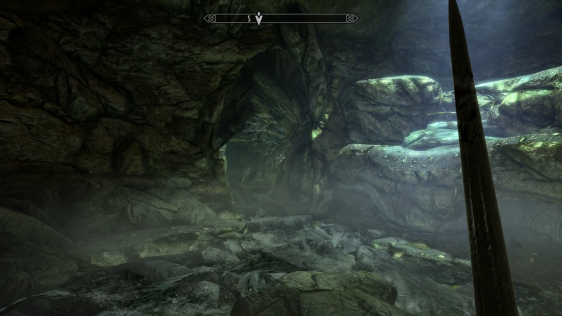
After some time in the caves, I was presented with an optional stealth segment involving a sleeping bear. Hadvar and I stepped past him quietly and made our way outside the suffocating caves into Skyrim. We appeared to be well away from the attacking dragon.
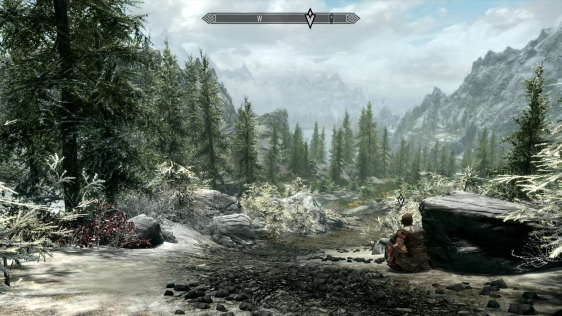
The initial view of Skyrim’s wilds was one of beauty and vastness. A path stretched out ahead of us, cutting through the rocky terrain and a variety of pine trees and low shrubs. We paused for a moment, making sure the way was clear. Hadvar then informed me of a place called Riverwood where his uncle, a blacksmith, would be willing to assist me. Despite his insistence that I shouldn’t follow him, Hadvar seemed like a decent enough fellow, and so we took the path to Riverwood together.
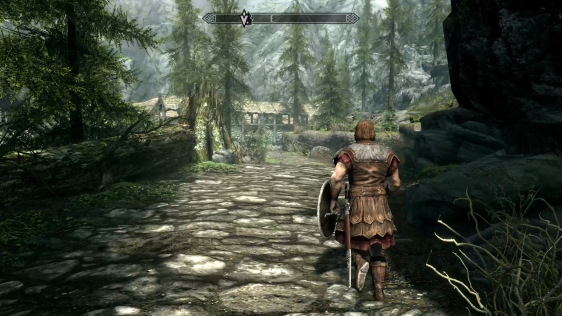
At the village, Hadvar’s uncle was willing to provide me with supplies, but he also pleaded for my help. Apparently I was the only one capable of letting the Jarl of Whiterun know that a dragon was on the loose and that the people were in need of aid. Of course, being the wonderful and silent protagonist that I am, I gave no indication of doing the contrary. I was now set free to proceed to Whiterun.
I opened up the map and saw that an icon was now marking Whiterun as a point of interest. The map also revealed several other locations for exploration. While this seemed like a good stopping point for this particular foray into Skyrim, I decided to test one last thing. I wanted to see if, upon reloading to the point where Hadvar and I emerged from the caves, I could strike off away from Riverwood and Whiterun from the get go.
I started up a save and opened the map again. (Note: I stuck with Hadvar instead of going with Ralof for consistency and because they both lead the player to Riverwood anyway.) An icon indicated Hadvar on the map, suggesting I was meant to listen to his spiel before proceeding. Ignoring him for the moment, I scanned the map and set a waypoint for Falkreath, which would require I travel south-west instead of north to Riverwood.
Exiting the map, I let Hadvar express that we were clear of the dragon before leaving the trail, pushing through plants and past some trees. As with the previous playthrough, I received a notification that the map had been updated and that the quest “Before the Storm” was available. This time I ignored what the game wanted of me and traversed the rough terrain. On my way to Falkreath, I took some damage jumping down from a small cliff, dodged some wolves and bandits, and ran into a dude, Plautis Carvain, on his way to a marriage celebration.

I soon reached Falkreath and entered Dead Man’s Drink, a cozy little establishment run by Valga Vinicia. We chatted for a bit about what she had for sale, local rumors, and work available in the region. My inquiry led to several quest prompts and leads.
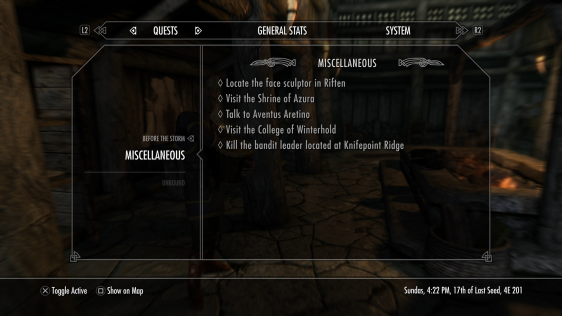
This is where I determined I had collected enough information and called it quits as it was evident that breaking away from Hadvar did not hinder my ability to play the game. New side quests were available to me, and I could easily select one or more of them to pursue before going to Riverwood or Whiterun.
Reflections:
I started my game analysis portion of this project with Skyrim because it is the oldest game on my list and because Bethesda is known, for better or worse, for their open worlds. This might provide an interesting baseline for the remaining games to be played and discussed in future posts.
In terms of this title, a few things stand out as note worthy. To start, much of the tutorial is linear. The first five minutes, and a minute or so after the character customization segment, restrict the player to looking around. However, having the player located in the back of a wagon on the way to the Imperials in Helgen serves as more than a narrative introduction—it also lays the groundwork for the kind of terrain and locations the player can encounter throughout the game. Much of Skyrim‘s terrain is mountainous, covered in trees and low growth, and the climate is cold. Of course, the wagon ride also provides some contextual information for the player in terms of the factions and politics at play in the world.
Unlike some open-world RPGs, Skyrim not only includes protagonist customization but a decently robust system as well (for the time, at least). The introduction to this element is rather clever in that the player must create themselves as they step up to be identified. Including such customization within the first six minutes of the game contributes to the illusion that the game is an open and pliable playground. Its careful placement serves as reprieve from the linear segment immediately before while also acting as assurance that agency will be granted upon the player after the heavily linear segment to follow. It also, of course, plants the seed of ownership in players.
The game establishes that the world is open through a number of design choices beyond character customization. While entering the village, I could see the mountains and forests beyond, the village was made up of multiple buildings, and even within the keep I could see the landscape beyond the walls and towers. Those locations weren’t accessible at the time, but their mere existence made me believe that they were real—that I could go beyond the walls and walk through the forests. As my observations above establish, the game is designed to funnel the player from point to point in these initial moments for sake of expediency. I couldn’t break out of the yard or climb the walls to escape the Imperials or the dragon; I had to follow the path set out before me whether that was entering the tower and climbing the stairs or sneaking past the dragon with Hadvar. The same can be said for the inside of the keep and the caves beneath.

I felt the game got especially interesting once outside the caves. Technically, depending on how long character customization takes, players are set free into the open world after roughly thirty minutes of gamplay. It would seem the heavily linear tutorial pays off in this regard. However, this does not mean that the game gives up on its guidance. Hadvar suggests you should split up even though you’ll arrive in the same location if you immediately follow the prompt to travel to Riverwood. I’d need to test this with other players, but my guess is that most end up following Hadvar despite his suggestion. The fact that he’s the only npc in sight contributes to this presumed inclination as does the shaping of the terrain. A path is clearly cut through the landscape, giant boulders and trees on either side help to funnel the player down the mountain, and Hadvar keeps to this path all the way to Riverwood. I also think this is the more inviting option as opposed to setting off away from Hadvar and the trail. The vastness of the world can be intimidating for the player, especially after having your hand held for the past twenty+ minutes.

The fact that Hadvar will wait for the player is further indication that the player should follow him to Riverwood. Anytime I intentionally fell behind or left the path for a few moments, Hadvar would pause and turn to look at me. He also leads the player toward some Guardian Stones and discusses them briefly—further reassurance that the player is exactly where she should be.
One final note from my gaming session relates to map availability. The map is accessible once the player leaves the caves. Not only does the map help to establish the scope of the game world, but this moment of access is an invitation to take in and appreciate that scope. In this case, it is the true indicator of the player’s freedom to explore and take on the world. Nearby locations are clearly designated, and an icon points to the next logical objective. The mere inclusion of locations other than Riverwood and Whiterun suggests that the player is free to choose direction, and that whatever there is to find in any of the locations will wait for the player to appear.
Thank you for taking the time to read this second installment of “First Steps: Freedom in the Open World.” It was a long one, I know.
Let me know what you think in the comments! And if you have any ideas for what I should look at or question in future posts, feel free to drop a suggestion.
I hope you’ll join me next week for a post discussing The Legend of Zelda: Breath of the Wild!






Leave a comment